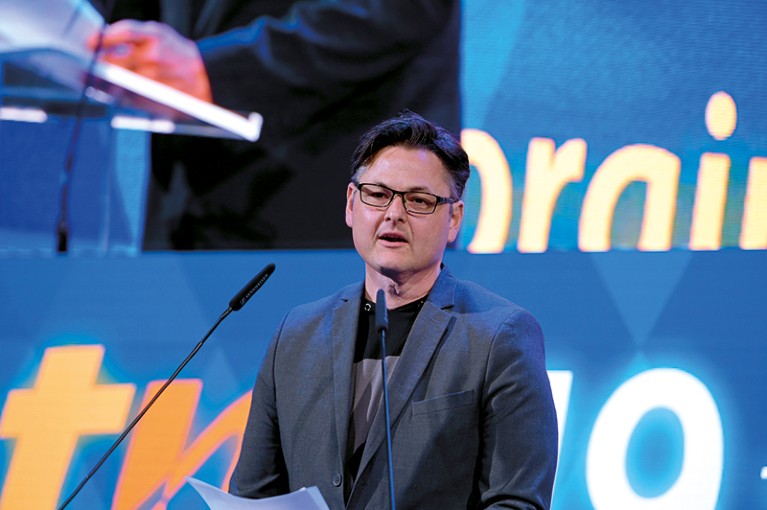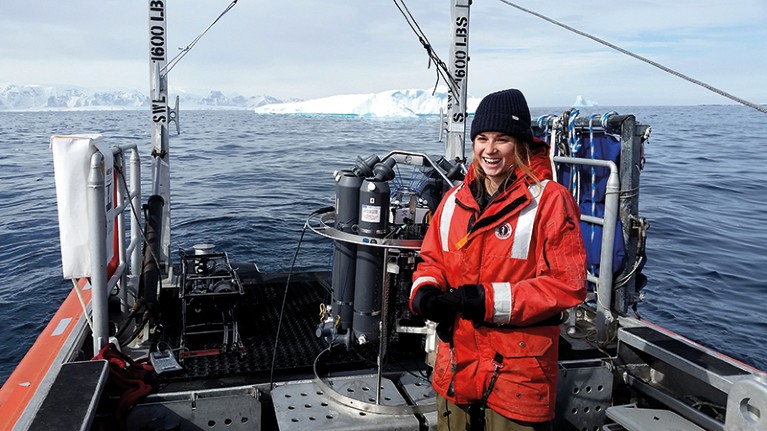
Renato Furter delivers a lightning talk at the 2019 Terena Networking Conference in Tallinn, Estonia.Credit: GÉANT
By the usual standards of conferences, a series of talks by five early-career researchers should add up to a full afternoon (at least) of slides, charts, equations and digressions. But when five PhD students spoke at the Health Data Research UK conference, held virtually on 23 June, the whole session, including questions and feedback, was set to be over in less than 40 minutes. The students presented 4-minute ‘lightning talks’, bite-sized bits of science that showcase the essence of their research. “It seemed like a good idea to have short talks instead of a tired audience,” says Fatemeh Torabi, a data scientist at Swansea University, UK, and one of the conference organizers.
Lighting talks were a feature of many pre-pandemic scientific gatherings, and their popularity carried over into virtual conferences and meetings. As in-person conferences slowly return, live lightning talks will strike once again. The appeal is clear: at their best, quick talks can get an audience to engage with a wide variety of topics in a short amount of time, says Paul Charlton, a science-communication instructor at the German Center for Infection Research in Munich. But if not done well, lightning talks can bring more chaos than light, he says. “Too many people talking too fast can lead to total cognitive fatigue.”
And even though the talks are short, the stakes can still be high. “You never know who’s in the room, so you should always strive to make a good impression,” Charlton says. “You’ll be surprised how much return you can get on that investment.”
Researchers at all career stages should know how to crystallize their work into quick, effective sound bites, Charlton says. Whether it’s a lightning talk at a conference or a short presentation as part of a grant application, the basic approach remains the same. The speaker needs to be organized, prepared and sufficiently well informed to make the most of their allotted minutes (see ‘Lightning tips’). “It’s not a matter of dumbing things down,” he says. “People think that because you only have a few minutes, it must be easier. But the opposite is true. It takes a real expert to make something simple.”
Full speed ahead
Even experts can make lightning-talk mistakes. Karen Bett, a policy officer at the Global Partnership for Sustainable Development Data in Nairobi, ran out of time for her talk, on antibiotic resistance, during a virtual conference in March sponsored by the Center for Effective Global Action. “It was the first lightning talk I’ve even given that was really strict on the time,” she says. “The moderator cut me off.” In retrospect, she says, she should have spent less time setting the context for her talk and more time on the take-home messages. A little more practice would have helped, she acknowledges. “I went off my mental script and said more than I should have.”
Quick-hit format
Bett is willing to give lightning talks another try, but next time she’ll take a more deliberate approach. The quick-hit format has its advantages, she says. “The problem with a longer talk is that you can lose the audience,” she says. “Lightning talks are like speed dating. You need to get the message across and move to the next person. It’s efficient, but sometimes I question whether people are genuinely following and understand.”
Anna Wright, a first-year PhD student in environmental studies at the University of Colorado Boulder, tried to make the most of her 4 minutes in the virtual spotlight at a symposium of hydrologic scientists in April. Because the audience had a wide range of backgrounds, she literally set the scene for her research by showing snow patterns along stream beds in the McMurdo Dry Valleys, an Antarctic desert of sand, rocks and intermittent streams fed by melting glaciers. For her, the slides — including satellite and ground-based images — did much of the work. “I really thoughtfully picked out the photos that I used,” she says. “I found a lot more power in imagery.”

Anna Wright at the US Palmer research station, Antarctica.Credit: Emmalina Glinskis
Wright has not yet visited the Dry Valleys — a planned trip last year was cancelled because of the pandemic — and says she might have had trouble filling a long talk. The lightning format gave her a chance to think about and describe the key focus of her work: tracking the carbon that enters the ecosystem through wind-blown algal mats. “It’s helpful to go back and pick out the important parts of your research,” she says.
Swipe left, swipe right
Renato Furter, a software engineer at SWITCH, a Zurich-based foundation that manages internet networks for Swiss universities and research centres, says he’s out of the lightning-talk game. That’s partly because his most recent effort, in front of a live audience at the 2019 Terena Networking Conference (TNC) in Tallinn, was such a hit. “I set the bar too high,” he says. “I don’t think I want to put in that kind of effort again.” He says it took him about a solid week of work spread out over two months to build his presentation, entitled “But on <insert favourite service> I get <insert favourite feature> for free!” A cinematic work with video footage and background music, it won the conference’s prize for the best lightning talk, which Furter says was his primary goal. “I got my 5 minutes of fame,” he says.
It wasn’t the first time that Furter had stretched convention for a lighting talk. In 2016, he did an entire talk in rhyme, featuring lines such as: “In Open Stack, an account is created, and that’s how the user is authenticated.” It became part of a tradition of untraditional talks at the TNC. In 2018, a speaker asked the crowd to turn on the torch setting on their smartphone and wave it (or “swipe”) to the left or right throughout the talk, a sort of live version of the Tinder dating app but for computer-security concepts, not companionship. “Some people try to be original, and some people just try to get their idea across,” Furter says.
The one thing that’s not negotiable at TNC conferences is time. A large clock starts counting down as soon as a talk begins, and the audience will clap a speaker off as soon as 5 minutes are up.
Charlton has observed that some conferences are a little lax about lightning-talk time limits, especially if the speaker is a prominent scientist. But if one speaker after another goes over the mark, the whole point of the session can be lost. “Lightning talks are supposed to be wonderfully efficient,” he says. “But it becomes a complete nightmare and a traffic jam. People are lucky if they can get to dinner at eight o’clock in the evening.”
Charlton says conference organizers should think about their overall mission before packing a session with lightning talks. In some cases, the motives might be a little less than pure. “I don’t think it’s always driven by scientific excellence,” he says. “They want to make the agenda look busy.”
Torabi says past lightning-talk sessions at the Health Data Research conference have gone well, both for participants and for the audience. The format there has changed over the years. When she gave a lightning talk about stroke risk and atrial fibrillation in 2019, each speaker had only one minute and one slide to deliver their message. “We were running on and off the stage,” she says. The speakers this year will have a relatively generous 4 minutes and no stage to worry about, but the basic approach will remain the same: short talks about big topics. The reward, it’s hoped, will be another successful conference briefly illuminated by lightning.


 Good presentation skills benefit careers — and science
Good presentation skills benefit careers — and science
 Why your scientific presentation should not be adapted from a journal article
Why your scientific presentation should not be adapted from a journal article
 Linguistic tricks to grab your online audience’s attention
Linguistic tricks to grab your online audience’s attention
 Collection: Events Guide
Collection: Events Guide







